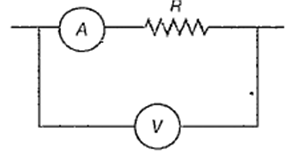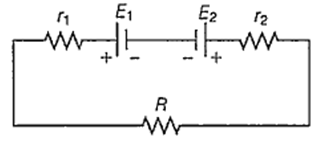 Multiple Choice Questions
Multiple Choice QuestionsThree resistances 2 Ω, 3 Ω and 4 Ω are connected in parallel. The ratio of currents passing through them when a potential difference is applied across its ends will be
5 : 4 : 3
6 : 3 : 2
4 : 3 : 2
6 : 4 : 3
D.
6 : 4 : 3
We know that potential drop across a resistance,
V = IR
V = constant
i.e,
Four identical cells of emf E and internal resistance r are to be connected in series. Suppose, if one of the cell is connected wrongly, the equivalent emf and effective internal resistance of the combination is
2E and 4r
4E and 4r
2E and 2r
4E and 2r
In the circuit shown below, the ammeter and the voltmeter readings are 3A and 6V respectively. Then, the value of the resistance R is

< 2 Ω
2 Ω
≥ 2 Ω
> 2 Ω
Two cells of emf E1 and E2 are joined in opposition (such that E1 > E2). If r1 and r2 be the internal resistances and R be the external resistance, then the terminal potential difference is

The resistance ofa bulb filament is 100 Ω at a temperature of 100°C. If its temperature coefficient of resistance be 0.005 per°C, then its resistance will become 200 Ω at a temperature
500°C
300°C
200°C
400°C
In Wheatstone network, P = 2 Ω, Q = 2 Ω, R = 2 Ω and S = 3 Ω. The resistance with which S is to be shunted in order that the bridge may be balanced is
4 Ω
1 Ω
6 Ω
2 Ω
Two parallel wires 1 m apart carry currents of 1 A and 3 A respectively in opposite directions. The force per unit length acting between two wires is
6 × 10-5 Nm-1 repulsive
6 × 10-7 Nm-1 repulsive
6 × 10-5 Nm-1 attractive
6 × 10-7 Nm-1 attractive
Mobility of free electrons in a conductor is
directly proportional to electron density
directly proportional to relaxation time
inversely proportional to electron density
inversely proportional to relaxation time
Variation of resistance of the conductor with temperature is as shown

The temperature coefficient (α) of the conductor is
mR0
m2R0
